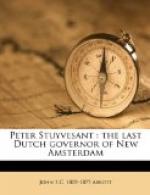The English thus baffled, again took their sloop and sailed down the bay, to a point between Rensselaer’s Hook and Sandy Hook, where they were about to renew their endeavors when Ensign Crygier again overtook them. “You are traitors,” he exclaimed. “You are acting against the government to which you have taken the oath of fidelity.” “This whole country,” they replied, “has been given to the English by his Majesty the king of England.”
Thus the antagonistic parties separated. The Dutch sloop returned to New Amsterdam. The next day a number of sachems came to New Amsterdam and sold to Governor Stuyvesant the remainder of the lands on the Raritan, which had not previously been transferred to the Dutch.
One John Scott, an Englishman of turbulent character, and a zealous royalist, petitioned king Charles Second to bestow upon him the government of Long Island. In his petition, which was referred to the Council for Foreign Plantations, he said:
“The Dutch have of late years, unjustly obtruded upon and possessed themselves of certain places on the mainland of New England, and some islands adjacent, as in particular on Manhattan and Long Island, being the true and undoubted inheritance of his Majesty.”
In reply to this petition, Scott with two others, was appointed a committee to prepare
“a statement of the English title to those lands; with an account of the Dutch intrusion, their deportment since and management of that possession, their strength, trade and government there, and of the means to make them acknowledge and submit to his Majesty’s government or by force to expulse them.”
Armed with this authority, Scott came to America, where he was very cordially received by the authorities in New Haven. Connecticut invested him with the powers of a magistrate throughout the whole of Long Island, and Governor John Winthrop administered to him the oath of office. Scott entered vigorously upon his work of wresting western Long Island from the dominion of the Dutch, whom he denounced as “cruel and rapacious neighbors who were enslaving the English settlers.”
He visited most of the villages, where large numbers of the English resided, but found that there was strong opposition to being annexed to Connecticut. Many of them, particularly the Baptists and the Quakers, were very unwilling to come under the rule of the Puritan government.
Consequently, six of the towns, Hempstead, Gravesend, Flushing, Middlebury, Jamaica and Oyster Bay, formed a combination to govern themselves independently of Connecticut, and empowered Scott to act as their President, until the king of England should establish a permanent government among them. Scott in his pride now unfurled an almost imperial banner. Placing himself at the head of one hundred and seventy armed men, horse and foot, he set out to compel the neighboring Dutch villages to renounce their allegiance to Holland and to subject themselves to his sway.




